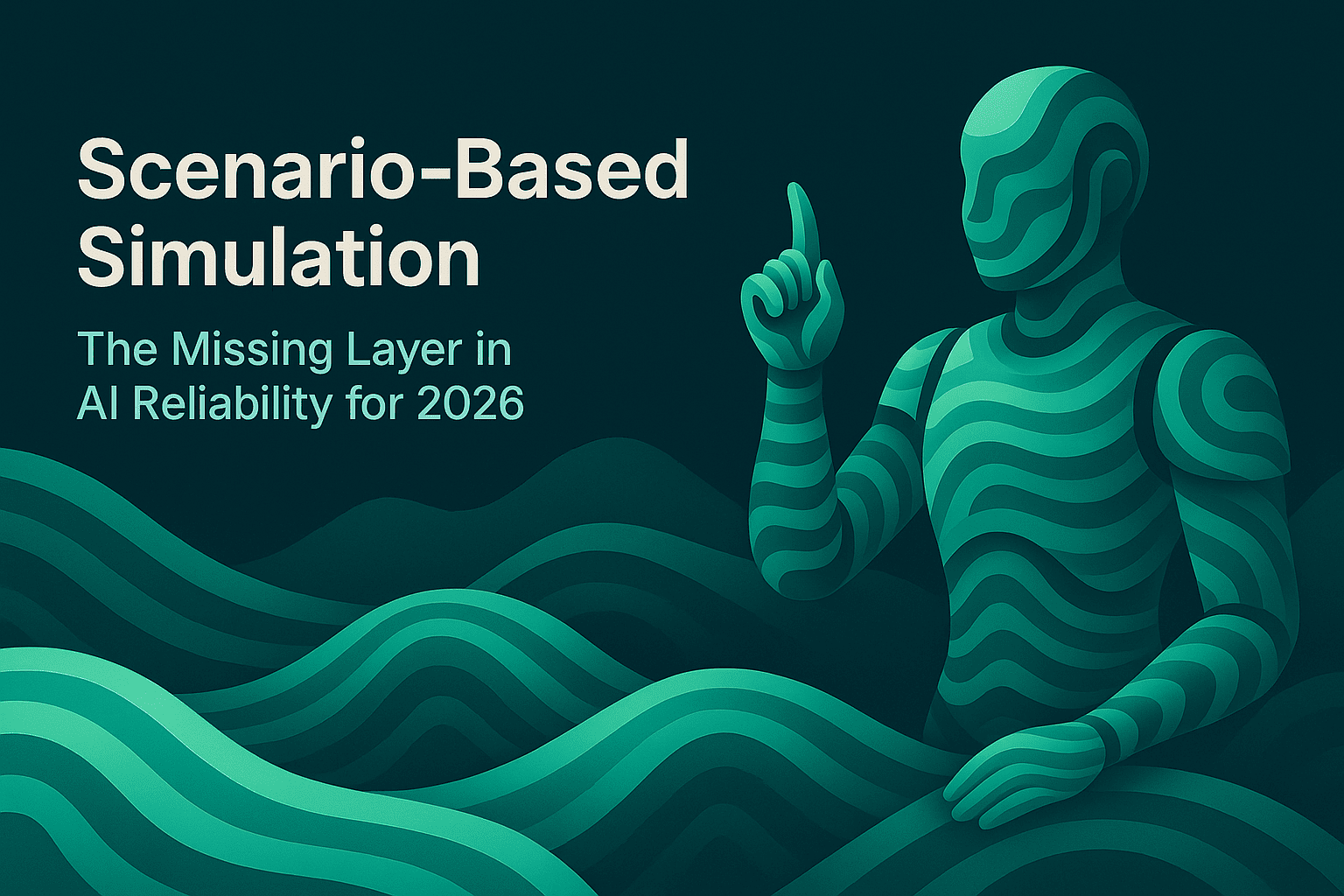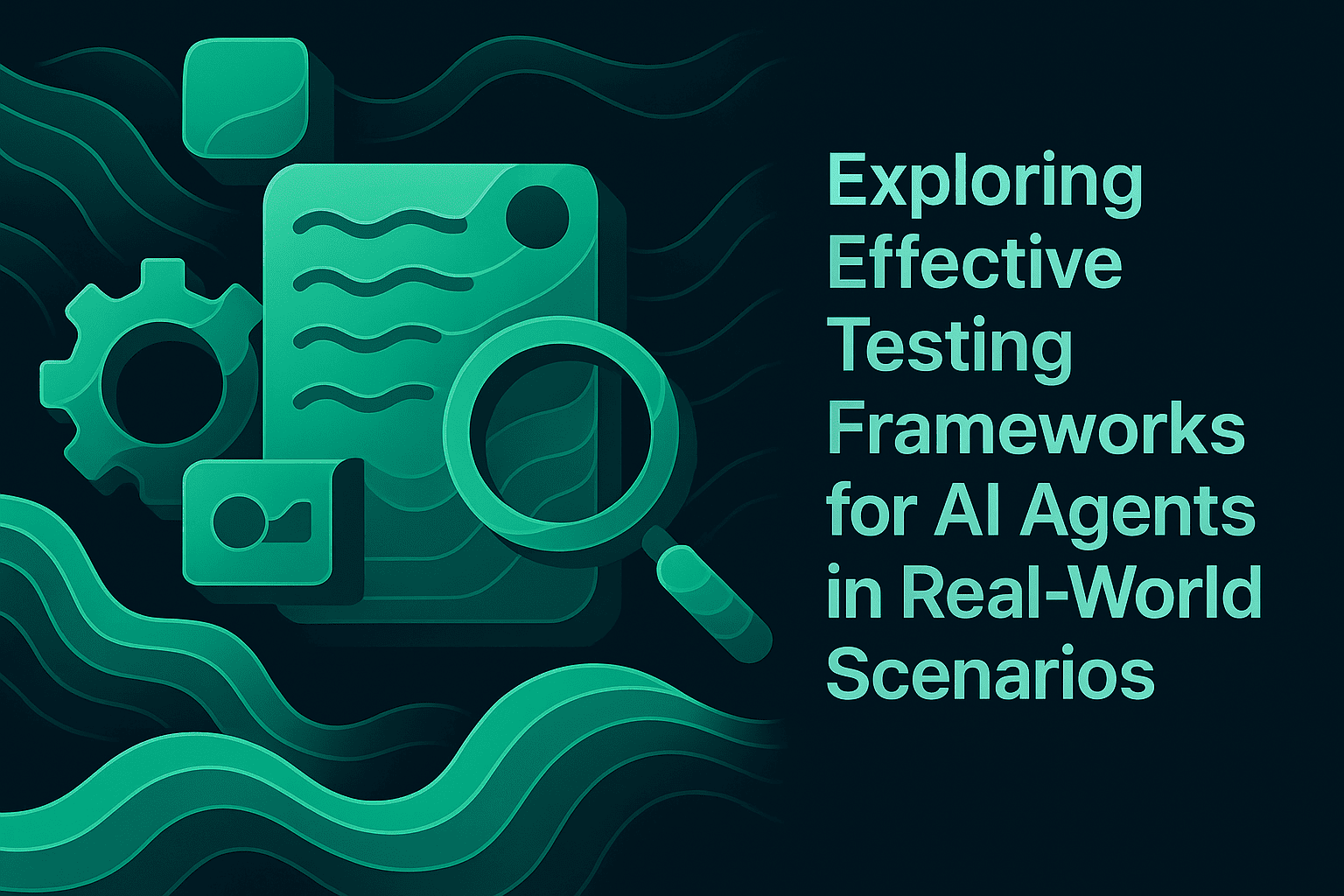Scenario-Based Simulation: The Missing Layer in AI Reliability for 2026

TL;DR:
Scenario-based simulation is the reliability layer AI teams need in 2026. By running multi-turn, persona-driven conversations against realistic scenarios with defined steps, tools, and context, and scoring them with evaluators, teams expose failure modes early, harden safety and policy adherence, and make data-backed release decisions. Maxim unifies this loop: define datasets, simulate, evaluate, compare versions, and observe production, so reliability becomes measurable and repeatable.
The Gap in AI Reliability Today
AI agents now execute multi-step tasks, call tools, enforce policies, and operate across text and voice. Yet most teams still rely on single-turn checks, ad hoc QA, or narrow unit tests that fail to capture multi-turn dynamics, tool orchestration, and policy adherence. This gap creates reliability risks: context drift over long conversations, brittle tool invocation, hallucinations under pressure, and safety violations in edge cases. Scenario-based simulation closes this gap by testing agents across realistic, multi-turn conversations with defined goals, real-world scenarios scenarios, personas, tools, and context, then evaluating outcomes with consistent metrics. Simulations pair a synthetic virtual user with agents and evaluate trajectory, safety, latency, and cost.
Why Current AI Testing Falls Short
Traditional testing treats AI like static functions. In practice, agents face diverse personas, conversation styles, and incomplete or adversarial inputs. Single-turn evals miss failure modes like context loss, inconsistent responses across turns, or misaligned tool choices. Multi-turn simulation exposes these problems by: • Running conversation trajectories that validate context maintenance and recovery from misunderstandings. • Stress-testing boundary conditions and adversarial inputs to detect manipulation attempts and safety violations. • Cataloging failure modes with detailed traces for reproducible debugging and root cause analysis.
Maxim's approach emphasizes multi-turn, scenario-based sessions with evaluator-driven analysis at session, trace, and span levels, enabling teams to quantify task success, step adherence, faithfulness to context, and drift.
What Scenario-Based Simulation Actually Means
Scenario-based simulation is the systematic generation of multi-turn conversations that mirror production workflows across various real world scenarios and user personas with explicit success criteria. Teams define scenarios (for example, refund for defective product within five turns), expected steps (verify purchase, apply policy, initiate refund), personas (frustrated customer, confused novice), tools (refund processor, policy lookup), and context sources (policies, FAQs). Simulations run end to end, logging requests, responses, tool calls, and intermediate states. Evaluators then score transcripts for task completion, trajectory compliance, safety, hallucination risk, latency, and cost. This turns qualitative judgments into measurable agent reliability signals. Agent simulation organizes scenarios and expected steps as datasets and evaluates conversations with prebuilt and custom metrics.
Why 2026 Is the Turning Point
By 2026, enterprises are standardizing agentic workflows for customer service, sales, internal support, and domain-specific copilots. As deployments scale, quality expectations shift from "works most of the time" to "measurable reliability under diverse real-world conditions." Scenario-based simulation becomes essential for: • Pre-release confidence: Catch regressions and failure modes before production with automated suites. • Continuous validation: Compare versions across evaluators and personas to drive data-backed releases. • Governance: Enforce policy adherence and safety constraints, then trace outcomes for auditability.
The simulation and evaluation stack operationalizes this pattern: define datasets, run multi-turn simulations, evaluate with flexible metrics, and connect observability for live quality checks. This creates a repeatable pathway from prototype to production reliability.
How Scenario-Based Simulation Strengthens Reliability
Scenario-based simulation fortifies agent reliability across six dimensions: • Task success under constraints: Evaluate whether agents meet scenario goals within turn limits and follow expected steps, not just produce plausible text. Detailed evaluator configurations ensure consistency across runs. • Context integrity across turns: Detect and reduce drift in longer interactions by inspecting trace and span-level decisions. • Tool-use correctness: Validate function calls, parameters, and sequencing using trajectory evaluators aligned to expected tool calls. • Safety and policy compliance: Identify PII leakage, jailbreak attempts, and policy violations with consistent safety evaluators. • Efficiency metrics: Track turns-to-resolution, latency, and cost per scenario to balance quality with operational performance. • Reproducible debugging: Re-run simulations from any step, isolate failing branches, and compare agent configurations scientifically.
This multi-dimensional view replaces anecdotal QA with measurable reliability.
The New Reliability Loop
Reliability is not a one-off checklist. It is a loop that compounds learning: • Design: Define scenario datasets with explicit steps, personas, tools, and context. • Simulate: Run multi-turn sessions to mirror production diversity and edge cases. • Evaluate: Apply rule-based, statistical, and LLM-as-a-judge evaluators at session, trace, and span levels. • Compare: Benchmark versions by scenario and persona, identify regressions early. • Observe: Connect production observability to validate live sessions against the same metrics used pre-release. • Curate: Feed production insights back into datasets to evolve coverage and keep tests representative.
Maxim enables this loop end to end with simulation, evaluation, experimentation, and observability in one workflow.
How to Implement Scenario-Based Simulation with Maxim
Maxim enables teams to implement a scenario suite that maps cleanly to reliability goals. • Create agent datasets: Scenarios and expected steps are organized as datasets that encode goals and trajectories. Teams include expected tool calls and conversation history for continuity. • Configure simulated sessions: From an endpoint, teams select a dataset, set persona, attach reference tools and context sources, and enable evaluators like PII detection and trajectory compliance. This ensures parity with production behavior. • Execute runs and review results: Maxim enables teams to inspect transcripts and evaluator outcomes. Dashboards compare versions and highlight trends. • Instrument tracing: Maxim captures decisions, tool calls, and retrievals at session, trace, and span levels for targeted debugging. This directly supports agent tracing and agent debugging workflows. • Iterate and benchmark: Teams update prompts, tool definitions, or context, then re-run simulations and compare across cost, latency, and quality metrics. LLM-as-a-judge augments evaluator signal and reviewer efficiency. • Wire into CI/CD: Maxim enables automated nightly runs and merge blocking when evaluator thresholds fail. Teams use consistent metrics across pre-release and production to make releases data-driven. • Connect observability: Maxim monitors live logs, runs online evaluations on production traces, and routes flagged sessions to human review queues when automated signals indicate risk. Production monitoring capabilities close the loop between testing and deployment.
FAQ
What's the difference between single-turn evals and scenario-based simulation?
Single-turn evals judge one response in isolation. Scenario-based simulation runs full, multi-turn conversations with goals, constraints, personas, tools, and context, then measures task completion, step adherence, safety, latency, and cost. This captures context drift and tool orchestration issues that single-turn tests miss. Simulation overview provides the foundation.
How do personas improve reliability testing?
Personas introduce variation in emotion, expertise, and communication style, forcing agents to adapt tone and trajectory. This surfaces failures hidden by "neutral" tests and ensures coverage across real user types. Examples and guidance appear in simulation configuration.
What should my first scenarios include?
Tie scenarios to business outcomes with explicit steps and constraints. For example: refund for a defective product within five turns, including identity/purchase verification, policy application, tool invocation, and confirmation. Implementation patterns are in simulation runs.
Which evaluators matter most to start?
Begin with task success and trajectory compliance, then add safety (PII, policy), faithfulness/grounding, and efficiency (latency, cost). Maxim supports rule-based, statistical, and LLM-as-judge evaluators across session, trace, and span. Browse the evaluator store in Agent Simulation & Evaluation.
How do I wire simulation into CI/CD?
Automate nightly suites and block merges when evaluator thresholds fail. Use consistent metrics to compare versions over time, then connect observability to validate live sessions against the same criteria. Workflows in simulation runs and agent observability enable this integration.
Can I test tools and context sources realistically?
Yes. Attach production tools and policy/context sources to simulations to validate tool selection, parameters, and retrieval faithfulness under real constraints. Configuration details appear in simulation setup.
How do I debug failures reproducibly?
Use trace and span-level instrumentation to re-run from any step, inspect tool calls, retrievals, and intermediate state, and isolate root causes. This capability is covered in agent observability.
Conclusion
Scenario-based simulation is the reliability layer teams need to meet 2026 expectations for agentic systems. It transforms evaluation from isolated prompts into multi-turn, production-like journeys with clear success criteria, personas, tools, and context. By combining simulations with flexible evaluators, distributed tracing, and live observability, teams get reproducible debugging, measurable safety, and data-backed release decisions.
Maxim provides the full-stack foundation teams need: define scenario datasets, run multi-turn simulations, evaluate with prebuilt and custom metrics, iterate in experimentation, and monitor live quality with observability. To deploy trustworthy AI at scale, make scenario-based simulation a first-class practice across engineering and product workflows.
Ready to accelerate AI agent reliability with scenario-based simulation? Sign up now to start testing agents across realistic scenarios, or book a demo to see how leading teams are shipping trustworthy AI at scale.


